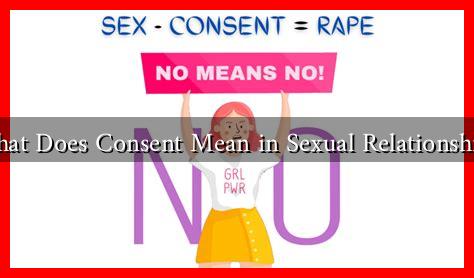-
Table of Contents
What Does Consent Mean in Sexual Relationships?
Consent is a fundamental aspect of any sexual relationship, serving as the cornerstone of mutual respect and understanding between partners. However, the concept of consent is often misunderstood, leading to confusion and, in some cases, harmful situations. This article aims to clarify what consent means in sexual relationships, its importance, and how it can be effectively communicated.
Understanding Consent
At its core, consent refers to the agreement between participants to engage in sexual activity. It is essential that this agreement is given freely, without any form of coercion or manipulation. Consent is not a one-time event; it must be ongoing and can be revoked at any time. Here are some key elements that define consent:
- Informed: All parties must have a clear understanding of what they are consenting to.
- Freely Given: Consent must be given voluntarily, without pressure or intimidation.
- Reversible: Anyone can change their mind about consent at any time.
- Enthusiastic: Consent should be expressed with eagerness and willingness.
- Specific: Consent for one activity does not imply consent for another.
The Importance of Consent in Sexual Relationships
Consent is crucial for several reasons:
- Promotes Respect: Consent fosters a culture of respect and understanding between partners.
- Prevents Misunderstandings: Clear communication about consent helps avoid confusion regarding intentions and boundaries.
- Reduces Risk of Assault: Understanding and practicing consent can significantly lower the risk of sexual assault and abuse.
- Empowers Individuals: Consent empowers individuals to express their desires and boundaries openly.
Statistics on Consent and Sexual Assault
Understanding the statistics surrounding consent can shed light on its importance in sexual relationships. According to the Rape, Abuse & Incest National Network (RAINN), an American is sexually assaulted every 68 seconds. Furthermore, studies indicate that:
- Only 20% of female college students who experience sexual assault report it to law enforcement.
- Approximately 90% of sexual assault victims are female, and 10% are male.
- In 70% of sexual assaults, the victim knew the perpetrator.
These statistics highlight the critical need for education on consent and the importance of creating a safe environment for open discussions about sexual boundaries.
How to Communicate Consent Effectively
Effective communication is key to ensuring that consent is understood and respected. Here are some strategies for communicating consent:
- Be Direct: Use clear language to express your desires and boundaries.
- Ask Questions: Encourage open dialogue by asking your partner how they feel about specific activities.
- Check In: Regularly check in with your partner during intimate moments to ensure they are comfortable.
- Use Non-Verbal Cues: Pay attention to body language and other non-verbal signals that may indicate comfort or discomfort.
Case Studies: Real-Life Implications of Consent
Several high-profile cases have brought the issue of consent into the public eye, highlighting its complexities and the consequences of its violation. For instance, the #MeToo movement has empowered countless individuals to share their experiences of sexual harassment and assault, emphasizing the need for clear consent in all interactions. These stories serve as powerful reminders of the importance of understanding and respecting consent.
Conclusion
In summary, consent is a vital component of healthy sexual relationships. It is essential that all parties involved understand what consent means and how to communicate it effectively. By promoting a culture of respect, open dialogue, and education about consent, we can work towards reducing the prevalence of sexual assault and fostering healthier relationships. Remember, consent is not just a legal requirement; it is a moral obligation that ensures the dignity and autonomy of every individual involved.
For more information on consent and sexual health, consider visiting resources like RAINN or Planned Parenthood.


